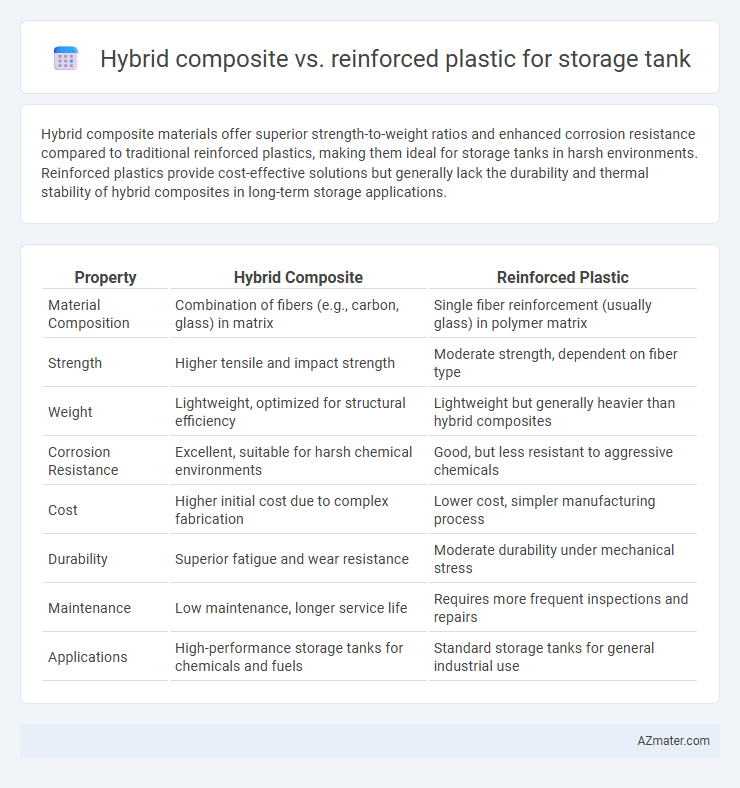Hybrid composite materials offer superior strength-to-weight ratios and enhanced corrosion resistance compared to traditional reinforced plastics, making them ideal for storage tanks in harsh environments. Reinforced plastics provide cost-effective solutions but generally lack the durability and thermal stability of hybrid composites in long-term storage applications.
Table of Comparison
| Property | Hybrid Composite | Reinforced Plastic |
|---|---|---|
| Material Composition | Combination of fibers (e.g., carbon, glass) in matrix | Single fiber reinforcement (usually glass) in polymer matrix |
| Strength | Higher tensile and impact strength | Moderate strength, dependent on fiber type |
| Weight | Lightweight, optimized for structural efficiency | Lightweight but generally heavier than hybrid composites |
| Corrosion Resistance | Excellent, suitable for harsh chemical environments | Good, but less resistant to aggressive chemicals |
| Cost | Higher initial cost due to complex fabrication | Lower cost, simpler manufacturing process |
| Durability | Superior fatigue and wear resistance | Moderate durability under mechanical stress |
| Maintenance | Low maintenance, longer service life | Requires more frequent inspections and repairs |
| Applications | High-performance storage tanks for chemicals and fuels | Standard storage tanks for general industrial use |
Introduction to Storage Tank Materials
Hybrid composites and reinforced plastics are essential materials in modern storage tank construction due to their superior strength-to-weight ratios and corrosion resistance. Hybrid composites combine fibers such as glass and carbon within a polymer matrix, offering enhanced mechanical properties and chemical durability compared to conventional reinforced plastics that typically use a single fiber type. These materials improve longevity and reduce maintenance costs in storage tanks exposed to harsh environmental conditions and aggressive chemicals.
Understanding Hybrid Composites
Hybrid composites in storage tanks combine multiple reinforcement materials such as glass and carbon fibers to optimize strength, durability, and chemical resistance, outperforming traditional reinforced plastics that typically use a single fiber type. This synergistic effect enhances impact resistance and thermal stability while reducing overall weight, making hybrid composites ideal for demanding storage environments. The tailored fiber architecture in hybrid composites enables improved load distribution and longevity, addressing limitations commonly observed in reinforced plastic tanks.
Defining Reinforced Plastics
Reinforced plastics consist of a polymer matrix embedded with fibers such as glass, carbon, or aramid to enhance mechanical properties like strength and durability. These materials are widely used in storage tanks due to their corrosion resistance, lightweight nature, and high tensile strength. Compared to hybrid composites, reinforced plastics typically offer simpler manufacturing processes but may have limitations in tailored performance and multi-functional capabilities.
Key Material Properties Comparison
Hybrid composites offer superior mechanical strength and enhanced chemical resistance compared to reinforced plastics, making them more durable for storage tank applications. The higher tensile strength and improved impact resistance of hybrid composites facilitate better performance under stress and corrosive environments. Thermal stability and resistance to UV degradation in hybrid composites also surpass those of reinforced plastics, ensuring longer service life in outdoor storage conditions.
Strength and Durability Analysis
Hybrid composite materials exhibit superior strength and durability compared to traditional reinforced plastics in storage tank applications due to their synergistic combination of different fibers such as carbon and glass, which enhances mechanical properties and impact resistance. The multi-phase structure in hybrid composites reduces crack propagation and improves fatigue life, making them ideal for high-pressure and corrosive environments. Reinforced plastics, while cost-effective and corrosion-resistant, generally offer lower tensile strength and less resistance to long-term environmental degradation, limiting their use in demanding storage tank conditions.
Corrosion Resistance in Storage Applications
Hybrid composite materials exhibit superior corrosion resistance compared to reinforced plastics in storage tank applications, particularly in harsh chemical environments. The combination of different fibers and resin systems in hybrid composites enhances durability and minimizes degradation caused by acids, alkalis, and solvents commonly stored in industrial tanks. This improved resistance extends the service life and reduces maintenance costs, making hybrid composites a more reliable option for corrosion-prone storage conditions.
Cost Efficiency and Lifecycle Considerations
Hybrid composite storage tanks offer superior cost efficiency through enhanced strength-to-weight ratios and increased durability compared to reinforced plastic, reducing maintenance and replacement costs over time. Reinforced plastic tanks, while initially cheaper, often incur higher long-term expenses due to susceptibility to environmental degradation and lower resistance to mechanical stress. Lifecycle analysis favors hybrid composites for their extended service life and reduced total cost of ownership in demanding storage applications.
Environmental Impact and Sustainability
Hybrid composites for storage tanks offer enhanced environmental benefits compared to reinforced plastics, as they utilize a combination of natural and synthetic fibers, reducing reliance on purely petrochemical-based materials. The incorporation of bio-based fibers in hybrid composites lowers carbon footprint and improves recyclability, enhancing sustainability over the lifecycle of storage tanks. Reinforced plastics, typically reliant on fiberglass and thermosetting resins, pose greater environmental challenges due to limited recyclability and higher emissions during production and disposal.
Case Studies: Real-World Storage Tank Performance
Case studies demonstrate that hybrid composites in storage tanks exhibit superior chemical resistance, mechanical strength, and durability compared to traditional reinforced plastics. Real-world performance data from industrial storage applications reveal reduced maintenance costs and extended service life for hybrid composite tanks exposed to corrosive and high-stress environments. These findings underscore the enhanced reliability and cost-effectiveness of hybrid composite materials in demanding storage tank operations.
Choosing the Optimal Material for Storage Tanks
Hybrid composites offer superior strength-to-weight ratios and enhanced corrosion resistance compared to reinforced plastics, making them ideal for demanding storage tank applications. Reinforced plastics provide cost-effective solutions with good chemical resistance but may lack the durability and structural integrity of hybrid composites under extreme conditions. Selecting the optimal material depends on factors such as environmental exposure, load requirements, chemical compatibility, and long-term maintenance costs.

Infographic: Hybrid composite vs Reinforced plastic for Storage tank
 azmater.com
azmater.com